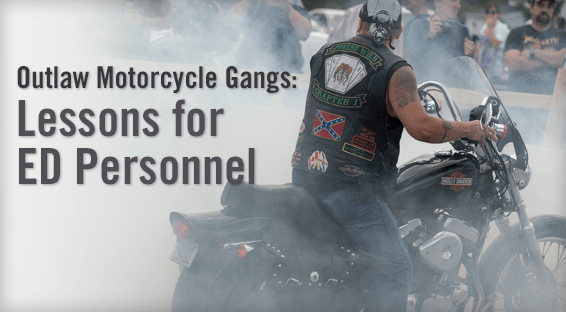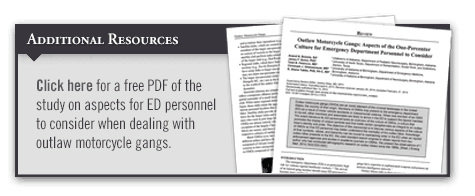Outlaw motorcycle gangs (OMGs) are an iconic element of the criminal landscape in the United States. “When an injured member of an OMG is brought to the ED, other members and associates are likely to come to the ED to support him,” say Anand N. Bosmia and colleagues. “The arrival of injured outlaw bikers and their associates can be concerning to ED personnel because of their potential for aggression and violence. Increasing knowledge on the symbols, values, and hierarchy of OMGs may help ED personnel understand the mentality of outlaw bikers and thereby optimize management strategies.”
In a study published in the Western Journal of Emergency Medicine, Bosmia and colleagues discuss various aspects of the culture of OMGs to inform ED personnel about outlaw bikers. The study notes that OMGs pose a challenge for ED personnel because they are well-organized, have an intricate intelligence network, and are capable of mobilizing members quickly to assist injured comrades.
Important Characteristics
Many outlaw bikers refer to their organizations as “one-percenter” motorcycle clubs (MCs) rather than gangs. The term “one-percenter” originated from a statement made in 1947 by the American Motorcycle Association, which proclaimed that 99% of the motorcycling public abides by the law and the remaining 1% does not. Outlaw bikers wear the diamond-shaped “1%” patch if their MC is immersed in criminality and large enough to defend itself against all rivals. OMGs are divided into four categories (Table 1), with the larger one-percenter MCs topping the criminal hierarchy.
Almost all OMGs in the United States are entirely Caucasian, and many of these one-percenter MCs are racist and have strong links to white supremacists. OMGs composed of African Americans or mixed race members tend to be less extreme in their entrepreneurialism and organization than Caucasian OMGs. Most African-American OMGs are local or regional in their influence and are usually encountered on the East and West Coasts of the United States.
Outlaw bikers wear patches and tattoos that have symbolic significance with respect to their gang’s subculture, and such insignia can provide information about a gang member’s social history, such as past incarcerations, drug use, and allegiance to the gang. Members of OMGs wear sleeveless and collarless jackets that identify the specific MC to which they belong. These jackets are often referred to as “cuts” or “colors” and are integral to a biker’s identity as a club member. If a biker’s colors must be removed during the course of his care in the ED, physicians and staff are urged to treat his colors with respect or risk eliciting hostile reactions.
Potential for Violence
Many members of OMGs will not hesitate to assault or kill someone whom they believe has disrespected one of their comrades. ED personnel should treat members of OMGs and their acquaintances with respect, regardless of whether their behavior warrants it. Outlaw bikers follow a “pack-like” mentality that demands that all members support each other to the fullest. Women who support the club can also facilitate violence in the ED by smuggling weapons to injured bikers and their associates, and outlaw bikers often possess hidden weapons that may be discovered during the course of their care in the ED.
ED personnel should clarify whether a biker’s injuries are due to a violent altercation with members of a rival gang, as adversaries may arrive at the hospital to kill the injured biker. When an injured biker’s supporters start to congregate at the hospital, ED personnel should be more vigilant for aggressive behavior and notify law enforcement.
Become Familiar With Locally Active OMGs
Memorizing all of the logos or insignias specific to each OMG is impractical for ED personnel. Instead, Bosmia and colleagues recommend that ED personnel find out which OMGs are active in their state of employment and become familiar with the “1%” patch and the hues worn by locally active OMGs and their respective support and satellite clubs. Information on several MCs that have been identified by the United States Department of Justice as being the most powerful OMGs is available online (Table 2).




 TimH
TimH